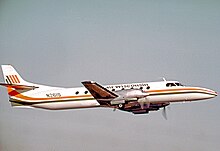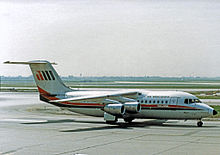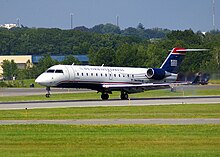Air Wisconsin
 | |||||||
| |||||||
| Founded | 1965[1] | ||||||
|---|---|---|---|---|---|---|---|
| Commenced operations | August 23, 1965[1] | ||||||
| AOC # | A6WA683W[2] | ||||||
| Hubs | |||||||
| Frequent-flyer program | AAdvantage | ||||||
| Alliance | Oneworld (affiliate) | ||||||
| Fleet size | 63 | ||||||
| Parent company | Harbor Diversified Inc. | ||||||
| Traded as | OTC Pink: HRBR[3] | ||||||
| Headquarters | Greenville, Wisconsin, U.S. | ||||||
| Key people | Robert Binns (President & CEO)[4] | ||||||
| Employees | 1,500 | ||||||
| Website | www | ||||||
Air Wisconsin Airlines is a regional airline based at Appleton International Airport in the town of Greenville, Wisconsin near Appleton, Wisconsin.[5]The company began operations as a United Express partner in 1985 on behalf of United Airlines. The partnership with United ended in 2005 at which time the airline became a feeder for US Airways, operating as US Airways Express. When US Airways merged into American Airlines in 2015, Air Wisconsin became an American Eagle affiliate. From March 2018 to April 2023, Air Wisconsin returned to operate as a United Express carrier, with hubs at Chicago–O'Hare International Airport (ORD) and Washington–Dulles. In April 2023, it shifted back once again to operating only for American Eagle. The agreement with American is set to conclude in April 2025, after which the airline plans to transition to only flying charter and Essential Air Service subsidized flights.
History
[edit]



In 1963 investors from the Fox Cities raised $110,000 to start a new airline.[6] The airline was established as an independent commuter air carrier in 1965 and started operations on August 23, 1965, just one day after the brand new Outagamie County Regional Airport was opened using de Havilland Dove commuter aircraft configured with nine passenger seats.[7] It was founded to connect Appleton with Chicago and initially had 17 employees and two de Havilland Dove aircraft.[8] According to the August 23, 1965, Air Wisconsin timetable, the airline was flying one route between Appleton and Chicago–O'Hare with four round trips on weekdays and two round trips on Saturdays and Sundays operated with the British-manufactured Dove twin prop aircraft.[9]
By the mid 1970s, Air Wisconsin was flying two small commuter turboprop airliner types, the de Havilland Canada DHC-6 and Fairchild Metroliner, and was operating a small hub at Chicago's O'Hare Airport with service primarily to destinations in Indiana, Michigan, and Wisconsin as well as to Minneapolis/Saint Paul from several small cities in Wisconsin.[10][11]
In September 1978 the airline was certified by the Civil Aeronautics Board (CAB) as a regional air carrier (Air Wisconsin previously had commuter air carrier status with the CAB). In October 1978 it had over $10 million in assets.[6] Joining Air Wisconsin in 1965 as traffic manager and eventually becoming president, Preston H. Wilbourne's leadership oversaw Air Wisconsin grow to an airline serving 29 cities in an eleven state area with 32 aircraft boarding over 10,000 passengers daily.[citation needed] Air Wisconsin gained the nicknames "Air Willy" and "Rag Tag"[6] and more recently "Air Wis" and "Air Wisky".[citation needed]
By 1985, Air Wisconsin had become a large independent regional air carrier operating BAe 146-200 and British Aircraft Corporation BAC One-Eleven jets as well as de Havilland Canada Dash 7 turboprops with flights as far west as Grand Island, Nebraska, and Minneapolis/Saint Paul, and as far east as Bridgeport and New Haven, Connecticut, with a large connecting hub located at Chicago's O'Hare Airport (ORD).[12][13] By early 1986, the airline was serving sixteen airports with its British-manufactured jets with flights to Appleton, Bridgeport, Cedar Rapids, Iowa, Chicago–O'Hare, Flint, Michigan, Fort Wayne, Indiana, Grand Island, Green Bay, Wisconsin, Kalamazoo, Michigan, Lincoln, Nebraska, Moline, Illinois/Quad Cities, New Haven, South Bend, Indiana, Toledo, Ohio, Waterloo, Iowa, and Wausau/Stevens Point, Wisconsin, Oshkosh, Wisconsin, with other flights and destinations in its route system being served with the Canadian-manufactured four engine Dash 7 turboprop.[14]
Air Wisconsin pioneered the concept of code sharing on behalf of United Airlines when the carrier began operating as United Express on May 1, 1985. As an independent air carrier prior to its business agreement with United to provide passenger feed, Air Wisconsin rapidly became the nation's largest regional airline in the 1980s.[citation needed] On May 17, 1985, it merged with Mississippi Valley Airlines (MVA) and continued to fly as United Express, operated by Air Wisconsin.
By late 1989 Air Wisconsin was operating United Express code share service from two United hubs: Chicago–O'Hare (ORD) and Washington–Dulles (IAD).[15] According to the Official Airline Guide (OAG) at this time, United Express flights were operated with BAe 146-200 jets and Fokker F27 turboprops nonstop to Chicago–O'Hare from Akron/Canton, Ohio, Appleton, Cedar Rapids, Champaign, Illinois, Fort Wayne, Green Bay, Kalamazoo, La Crosse, Wisconsin, Lansing, Michigan, Lexington, Kentucky, Moline/Quad Cities, Oshkosh, Wisconsin, Peoria, Illinois, Roanoke, Virginia, South Bend, Toledo, and Wausau, and with BAe 146-200 jets and Short 360 turboprops nonstop to Washington Dulles from Charleston, West Virginia, Charlottesville, Virginia, and Richmond, Virginia, as well as Harrisburg, Reading, and State College, Pennsylvania.
In 1990 Air Wisconsin acquired Denver-based Aspen Airways and was itself bought by United Airlines a year later.
During the 1990s, Air Wisconsin operated British Aerospace (BAe) ATP turboprop aircraft as well as BAe 146-100, BAe 146-200, and BAe 146-300 jet aircraft on United Express services. These were all large aircraft types when compared to other regional aircraft in operation at the time. Air Wisconsin was the only U.S. operator of the BAe ATP turboprop and also the BAe 146–300, which is the largest member of the BAe 146 family of jet aircraft. United Airlines sold Air Wisconsin and the BAe 146 fleet to CJT Holdings in 1993. Air Wisconsin was then renamed Air Wisconsin Airlines Corporation (AWAC) as UAL retained the rights to the Air Wisconsin name and logo. During the ski seasons, Air Wisconsin was operating BAe 146 jet shuttle service as United Express on the former Aspen Airways route between Aspen, Colorado, and Denver with at least fourteen daily nonstop flights in each direction.[16]
In February 1998 AWAC acquired the assets of Mountain Air Express including Dornier 328 turboprop aircraft which were used to expand United Express service in the west.[17] In the fall of 2003 AWAC acquired ten Bombardier CRJ jet aircraft from bankrupt Midway Airlines and became a feeder for AirTran Airways under the name AirTran JetConnect, but this relationship was discontinued in July 2004. Towards the end of the contract with United Airlines Air Wisconsin was unable to secure a long-term deal or extension to continue providing regional service for UAL. United failed to renew its contract with AWAC, allowing it to expire in April 2005, and the last flight under the United flag operated on April 16, 2006, using the BAe 146.
During 2005 AWAC invested $175 million U.S. into US Airways for their bankruptcy exit financing in exchange for a long-term contract operating as US Airways Express. In 2005 AWAC began operating all of its CRJ200 regional jets as a US Airways Express carrier with flight crew bases located in Philadelphia, New York LaGuardia, Washington Reagan National, and Norfolk, Virginia. US Airways merged with American Airlines in 2015 and Air Wisconsin operated as an American Eagle regional air carrier via a code sharing agreement with American until March 2018.
On November 20, 2014, it was reported that Air Wisconsin was nearing an agreement with Delta Air Lines to fly as a Delta Connection carrier beginning in January 2015. Under the terms of the deal, 26 CRJ200 aircraft were to be transferred to Air Wisconsin from Endeavor Air. In January 2015, Air Wisconsin said that negotiations had ended and that it did not want to fly under the Delta Connection brand.[18]
In 2016, it was announced that Air Wisconsin would close all of its ground handling operations in all cities served by the air carrier primarily due to the formation of a wholly-owned subsidiary of United called United Ground Express. This would leave only three American Eagle ground handling cities served, which the airline deemed uneconomical.
On March 1, 2017, Air Wisconsin announced a new agreement with United Airlines to once again operate under the United Express banner upon the expiration of the airline's current agreement with American Eagle in 2018. Additionally, the new agreement with United would provide for the creation of a career pathway program whereby Air Wisconsin pilots would be offered the opportunity to move up to United upon meeting its hiring standards.[19]
In September 2021, the company announced that they had signed a lease for at least 1 Bombardier CRJ200SF (converted cargo aircraft) set to enter service from December 2021.[20] The aircraft was never delivered and the cargo program has most likely been canceled.
On August 22, 2022, Air Wisconsin announced a five-year contract to operate up to 60 CRJ200s for American Eagle, starting in March of 2023. These aircraft are based at Chicago-O'Hare, to fill in for the Envoy Air ERJ 145s that will be transferred over to Piedmont Airlines. The airline also plans to utilize some CRJ700s. This ended their partnership with United Airlines.[21]
On January 10, 2025, Air Wisconsin announced it is terminating it's CRJ-200 operations for American Airlines to pursue independent operations providing charter and Essential Air Service subsidized flights.[22][23] It is anticipated that American and Air Wisconsin will continue an interline and codeshare relationship.[24]
Destinations
[edit]Air Wisconsin operates as American Eagle and serves 53 destinations with nearly 350 flights per day, transporting nearly six million passengers on an annual basis.[25][failed verification]
Crew domiciles
[edit]Operating as American Eagle, Air Wisconsin pilots and flight attendants have crew domiciles at the following locations:[26]
- Chicago, Illinois – O'Hare International Airport (ORD)
- Dayton, Ohio – Dayton International Airport (DAY)
- Milwaukee, Wisconsin – Milwaukee Mitchell International Airport (MKE)
Fleet
[edit]Current fleet
[edit]The Air Wisconsin fleet comprises the following aircraft (as of January 2024):[27][28]
| Aircraft | Fleet | Parked | Total | Passengers | Notes |
|---|---|---|---|---|---|
| Bombardier CRJ200 | 35 | 28 | 63 | 50 | 40 are operated for American Eagle of which 10 are parked. American Eagle contract will end in April 2025.[29] |
| Total | 35 | 28 | 63 |
Historical fleet
[edit]In 2016, the airline retired four CRJ200 regional jets that had met their structural time limit and sent them to Tupelo Regional Airport (TUP) in Tupelo, Mississippi.
The following aircraft types were formerly operated by Air Wisconsin:
Jet aircraft
[edit]- BAe 146-100 (via acquisition of Aspen Airways)
- BAe 146-200
- BAe 146-300 (only U.S. operator of the BAe 146-300)
- BAC One-Eleven
Turboprop aircraft
[edit]- Beechcraft Model 99
- British Aerospace ATP
- de Havilland Canada DHC-6
- de Havilland Canada Dash 7
- de Havilland Canada Dash 8-100
- de Havilland Canada Dash 8-300
- Dornier 328 (via acquisition of Mountain Air Express)
- Fairchild Metroliner
- Fokker F27
- Short 360 (via merger with Mississippi Valley Airlines)
- Short 330 (via merger with Mississippi Valley Airlines)
Piston aircraft
[edit]Aircraft maintenance
[edit]Air Wisconsin performs CRJ maintenance activities at the following locations:
- Appleton, Wisconsin (Appleton International Airport)
- Milwaukee, Wisconsin (Milwaukee Mitchell International Airport)
- Dayton, Ohio (Dayton International Airport)
Air Wisconsin also contracts aircraft maintenance-heavy checks at a facility in Oklahoma City, Oklahoma (OKC).
Past heavy check maintenance was conducted in Montreal, Canada, and Hot Springs, Arkansas (HOT).
Air Wisconsin's primary aircraft painting is located in Fort Worth, Texas – Meacham International (FTW).
Incidents and accidents
[edit]| Flight | Date | Aircraft | Routing | Location | Description | Injuries | Cause |
|---|---|---|---|---|---|---|---|
| Flight 671 | June 29, 1972 | de Havilland Canada DHC-6 Twin Otter | Chicago, IL- Sheboygan, WI- Appleton, WI |
near Appleton, WI | While approaching Outagamie County Regional Airport (Now Appleton International Airport), Flight 671 was involved in a midair collision over Lake Winnebago with a Convair 580 turboprop flown by North Central Airlines as Flight 290 which was operating a Green Bay-Oshkosh-Milwaukee-Chicago flight; both aircraft crashed into the lake and sank. | 13 fatal (8 on Flight 671) (5 on Flight 290) |
Pilots of both flights failed to see and avoid the others' aircraft[30] |
| Flight 965 |
June 12, 1980 | Swearingen Metro | Appleton, WI- Minneapolis, MN- Lincoln, NE |
near Valley, NE | The aircraft suffered a failure of both turboprop engines after entering a thunderstorm. The amount of water ingested into the engine caused a power interruption and a loss of control; plane hit the ground nose-down and right wing-down; plane skidded and ended inverted | 13 fatal, 2 serious |
Improper in-flight decisions by captain, complete failure of 2 engines[31] |
| Flight 3758 |
December 16, 2007 | Bombardier CRJ-200 | Philadelphia, PA- Providence, RI |
T. F. Green Airport | Miscommunication between the first officer and captain resulted in the first officer idling the engines on final approach. Soon a 2000 ft rate of descent developed, the captain attempted to salvage the landing and stalled the aircraft. The aircraft touched down at a 9 degree bank, collapsed the landing gear and the aircraft skidded to a halt left of the runway. | 0 injuries | The captain's attempt to salvage the landing from an instrument approach which exceeded stabilized approach criteria, resulting in a high sink rate, likely stall, and hard landing which exceeded the structural limitations of the airplane[32] |
See also
[edit]References
[edit]- ^ a b Norwood, Tom; Wegg, John (2002). North American Airlines Handbook (3rd ed.). Sandpoint, ID: Airways International. p. 5. ISBN 978-0-9653993-8-8. Archived from the original on November 28, 2016. Retrieved October 5, 2018.
- ^ "Federal Aviation Administration – Airline Certificate Information – Detail View". av-info.faa.gov. Retrieved June 27, 2019.
- ^ "Annual Report 10-K".
- ^ "Leadership". Air Wisconsin. Air Wisconsin Airlines. Retrieved September 2, 2019.
- ^
- * "Zoning Map Archived 2011-07-17 at the Wayback Machine." Town of Greenville. June 17, 2009. Retrieved on June 17, 2009.
- Mader, Becca. "Appleton's Air Wisconsin cuts costs to remain competitive." The Business Journal of Milwaukee. May 17, 2004. Retrieved on May 19, 2009.
- ^ a b c "Air Wisconsin: Commuter Success Story." Flight International. October 21, 1978. p. 1464.
- ^ "History – Appleton International Airport (ATW)". Appleton International Airport (ATW). Retrieved January 6, 2018.
- ^ "History". Airwis.com. Retrieved July 3, 2017.
- ^ http://www.timetableimages.com, August 23, 1965, Air Wisconsin timetable
- ^ http://www.departedflights.com, April 1, 1974, pocket Official Airline Guide (OAG), North American edition, Chicago O'Hare flight schedules
- ^ http://www.departedflights.com, September 1, 1973 & June 1, 1976, Air Wisconsin route maps
- ^ http://www.departedflights.com, February 15, 1985, Official Airline Guide, North American edition, Chicago O'Hare flight schedules
- ^ http://www.departedflights.com, June 1, 1985, Air Wisconsin route map
- ^ http://www.departedflights.com, January 6, 1986, Air Wisconsin system timetable
- ^ http://www.departedflights.com, December 15, 1989, Official Airline Guide (OAG), Chicago O'Hare & Washington Dulles flight schedules
- ^ departedflights.com. April 2, 1995, Official Airline Guide (OAG), Denver flight schedules
- ^ "Directory: World Airlines". Flight International. March 27, 2007. p. 69.
- ^ "Air Wisconsin nearing deal with Delta for 26 CRJ200s". Flightglobal.com. Retrieved July 3, 2017.
- ^ Mark Nensel (March 2, 2017). "United Airlines signs five-year CPA with Air Wisconsin | Airports & Routes content from". ATWOnline. Retrieved July 3, 2017.
- ^ "Air Wisconsin Dips Toe In Air Cargo". Flying. September 9, 2021. Retrieved September 11, 2021.
- ^ "American Airlines restore CRJ200". aeroxplorer.com. August 22, 2022.
- ^ Hardee, Howard (January 17, 2025). "Air Wisconsin plans to let capacity purchase agreement with American expire". Flight Global. Retrieved January 17, 2025.
- ^ Alexander, Rashad (January 14, 2025). "Appleton-based Air Wisconsin Airlines to end partnership with American Airlines in April". The Post-Crescent. Retrieved January 18, 2025.
- ^ "Air Wisconsin Announces Strategic Shift Toward Essential Air Service and Charter Operations". PR Newswire. January 10, 2025. Retrieved January 17, 2025.
- ^ "Profile". Airwis.com. Retrieved February 4, 2018.
- ^ "Crew Domicile Locations". Airwis.com. Retrieved July 9, 2023.
- ^ "Global Airline Guide 2016 (Part Two)". Airliner World (November 2016): 37.
- ^ "Profile". www.airwis.com. Retrieved June 18, 2018.
- ^ https://airlinegeeks.com/2025/01/10/air-wisconsin-american-end-regional-partnership/#
- ^ "Aircraft Accident Report North Central Airlines, Inc. Allison Convair 340/440ICV-580, N90858 and Air, Wisconsin Inc., DHC-6, N4043B near Appleton, Wisconsin June 29, 1972" (PDF). National Transportation Safety Board. April 25, 1973. Retrieved May 17, 2010.
- ^ "Aircraft Accident Report Air Wisconsin Inc. Swearingen SA-226 Metro N650S Valley, Nebraska June 12, 1980" (PDF). National Transportation Safety Board. December 9, 1980. Retrieved May 17, 2010.
- ^ "Aircraft Accident Report Air Wisconsin Airlines. Bombardier CL600-2B19, Providence, RI December 16, 2007". National Transportation Safety Board.
